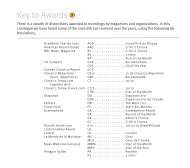MENDELSSOHN - Bis
MENDELSSOHN - Bis
MENDELSSOHN - Bis
Create successful ePaper yourself
Turn your PDF publications into a flip-book with our unique Google optimized e-Paper software.
Disc 1 · Symphonies Nos 1 & 4; ‘Ruy Blas’ Overture<br />
‘No. XIII’ – this impressive number was originally to be found on the autograph<br />
score of Felix Mendelssohn Bartholdy’s Symphony No. 1 in C minor, Op. 11.<br />
Evidently the fifteen-year-old composer initially reg arded this work, composed in<br />
1824, in the context of the twelve string sym pho nies that he had produced in the<br />
years 1821–23, an exploration of the essen tially con trapuntal tradition of the<br />
Berlin school. In comparison, how ever, the C minor symphony was in another<br />
league entirely. In terms both of scale and of the orchestral forces required, its<br />
point of ref erence was Viennese Classicism – Haydn, Mozart and especially Beet -<br />
hoven, to whom Men delssohn paid tribute through his choice of this historically<br />
signi ficant key. The sub se quent change of numbering, the allocation of an opus<br />
num ber and the fact that Men dels sohn himself instigated its publication all point<br />
to the leap forwards in terms of quality that this symphony represents – despite<br />
any allowances one might have to make for the composer’s youth.<br />
The first movement begins with a turbulent theme (Allegro di molto) that out -<br />
lines the underlying emotional tone – which, despite the key of C minor, is not<br />
entirely gloomy and tragic. The subsidiary theme consists of a descending, grad -<br />
ually accelerating wind idea, to which only a passing reference is made in the<br />
development section. A foreshortened recapitulation (which is also a trade mark of<br />
the mature Mendelssohn) is followed by a remarkably weigh ty coda that almost<br />
resembles a development section. The second move ment (Andante) transports us<br />
to an E flat major idyll that has the character of a rondo on account of the essen -<br />
tial role played by its opening theme in a variety of forms. Dis play ing a refined<br />
feel ing for sonority, a sunny dialogue emerges between the strings and wind<br />
instru ments. The forceful C minor minuet is slightly rem iniscent of the corres -<br />
ponding movement in Mozart’s Symphony No. 40 in G minor, K 550, whilst the<br />
sedately rocking A flat major trio leads us back to the minuet in a manner that is<br />
15








